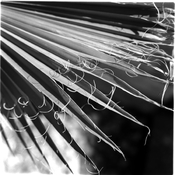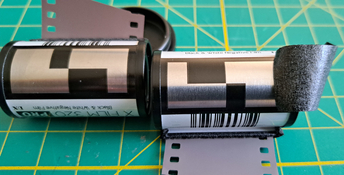{Moderator's Note: The Posts here have been copied from this earlier thread:
For that reason, you may find them quite familiar, and aparat will see a definite jump in his post count.
In addition to asparat's tests and comments, people are encouraged to add their results with or tests of the film}
I am slowly trying to return to photography after a long hiatus due to a long-term illness/disability. It turns out I missed out on a lot of new products over the past three-four years. I was intrigued by the Catlabs Pro 320 announcement. I bought a roll of 35mm and 120. The film arrived very quickly directly from Catlabs.
The film makes a great first impression. It's packaged very nicely, and I really like the artwork. Both 35mm and 120 are very easy to work with. The base is very clear, with B+F of only around 0.08. The film does not curl very much at all and dries very, very flat. I have not noticed any emulsion imperfections. The edge markings show the Catlabs branding. Clearly, a film made specifically for them.
Following the manufacturer's recommendation, I exposed the film at EI200. I ran a typical film test, using a recently calibrated and certified sensitometer, giving the 35mm variant an exposure of 3.68 Millilux Seconds, which is appropriate for ISO 200 film in my particular device. For example, Ilford HP5+ exposed at 3.38 gets essentially very close to box speed processed in D76, as does 400TX. Expired Neopan 400 gets about a 1/2 stop less speed.
Disclaimer first. I do not claim that my results are representative of the film's performance. It's possible that I made mistakes and/or that I got a bad batch of the emulsion. Please, keep that in mind.
In my test, the film ended up being severely underexposed. I processed four strips for 4, 5:40, 8, and 12 minutes in D76 1+1 at 20C, using a rotary processor with constant agitation. The resulting curves show a very long toe and rather steep G and CI values For example, flare-corrected CI ranges from 0.6 to 0.9. According to my calculations, effective film speed is around ISO 25.
Because my results are somewhat unexpected, I am hesitant to share a more detailed analysis. I should have bought more than one roll of 35mm and re-run the test. I have taken some pictures with my medium format camera and got decently exposed frames, mostly showing similar characteristics as the 35mm variant, namely, underexposed and overdeveloped. Unfortunately, I am still unable to make prints, so I cannot really tell much beyond basic exposure and a rough idea of tonality.
CatLABS X FILM 320 Pro now available in 35mm and 120
Which can be found here: https://www.photrio.com/forum/threads/catlabs-x-film-320-pro-now-available-in-35mm-and-120.194245/For that reason, you may find them quite familiar, and aparat will see a definite jump in his post count.

In addition to asparat's tests and comments, people are encouraged to add their results with or tests of the film}
I am slowly trying to return to photography after a long hiatus due to a long-term illness/disability. It turns out I missed out on a lot of new products over the past three-four years. I was intrigued by the Catlabs Pro 320 announcement. I bought a roll of 35mm and 120. The film arrived very quickly directly from Catlabs.
The film makes a great first impression. It's packaged very nicely, and I really like the artwork. Both 35mm and 120 are very easy to work with. The base is very clear, with B+F of only around 0.08. The film does not curl very much at all and dries very, very flat. I have not noticed any emulsion imperfections. The edge markings show the Catlabs branding. Clearly, a film made specifically for them.
Following the manufacturer's recommendation, I exposed the film at EI200. I ran a typical film test, using a recently calibrated and certified sensitometer, giving the 35mm variant an exposure of 3.68 Millilux Seconds, which is appropriate for ISO 200 film in my particular device. For example, Ilford HP5+ exposed at 3.38 gets essentially very close to box speed processed in D76, as does 400TX. Expired Neopan 400 gets about a 1/2 stop less speed.
Disclaimer first. I do not claim that my results are representative of the film's performance. It's possible that I made mistakes and/or that I got a bad batch of the emulsion. Please, keep that in mind.
In my test, the film ended up being severely underexposed. I processed four strips for 4, 5:40, 8, and 12 minutes in D76 1+1 at 20C, using a rotary processor with constant agitation. The resulting curves show a very long toe and rather steep G and CI values For example, flare-corrected CI ranges from 0.6 to 0.9. According to my calculations, effective film speed is around ISO 25.
Because my results are somewhat unexpected, I am hesitant to share a more detailed analysis. I should have bought more than one roll of 35mm and re-run the test. I have taken some pictures with my medium format camera and got decently exposed frames, mostly showing similar characteristics as the 35mm variant, namely, underexposed and overdeveloped. Unfortunately, I am still unable to make prints, so I cannot really tell much beyond basic exposure and a rough idea of tonality.
Last edited by a moderator:





